Analysis of Open Data Privacy Issues and Solutions
VerifiedAdded on 2022/08/21
|5
|1115
|14
Report
AI Summary
This report examines the privacy implications of open data initiatives, focusing on educational, transport, and weather data. It identifies key privacy issues, including violations of privacy, erosion of public trust, and data accuracy concerns. The report recommends safeguards such as risk-benefit analysis, privacy lifecycle assessment, and the implementation of operational structures to ensure data security and privacy. The analysis highlights the need for legislators to consider these measures when engaging in open data initiatives to protect citizens' personal information and maintain public trust. The paper provides an overview of the current scenario and provides recommendations for future improvements.
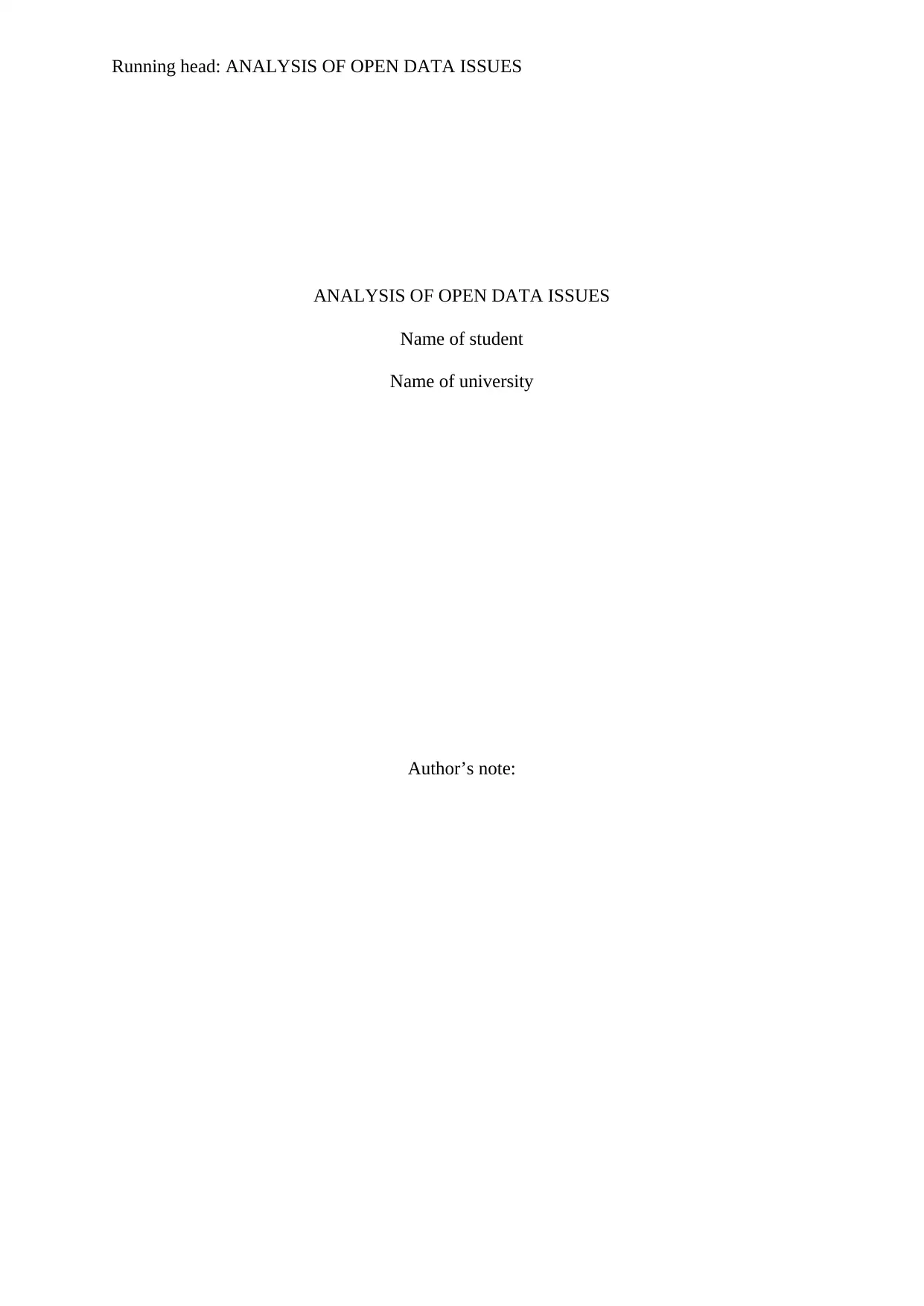
Running head: ANALYSIS OF OPEN DATA ISSUES
ANALYSIS OF OPEN DATA ISSUES
Name of student
Name of university
Author’s note:
ANALYSIS OF OPEN DATA ISSUES
Name of student
Name of university
Author’s note:
Paraphrase This Document
Need a fresh take? Get an instant paraphrase of this document with our AI Paraphraser
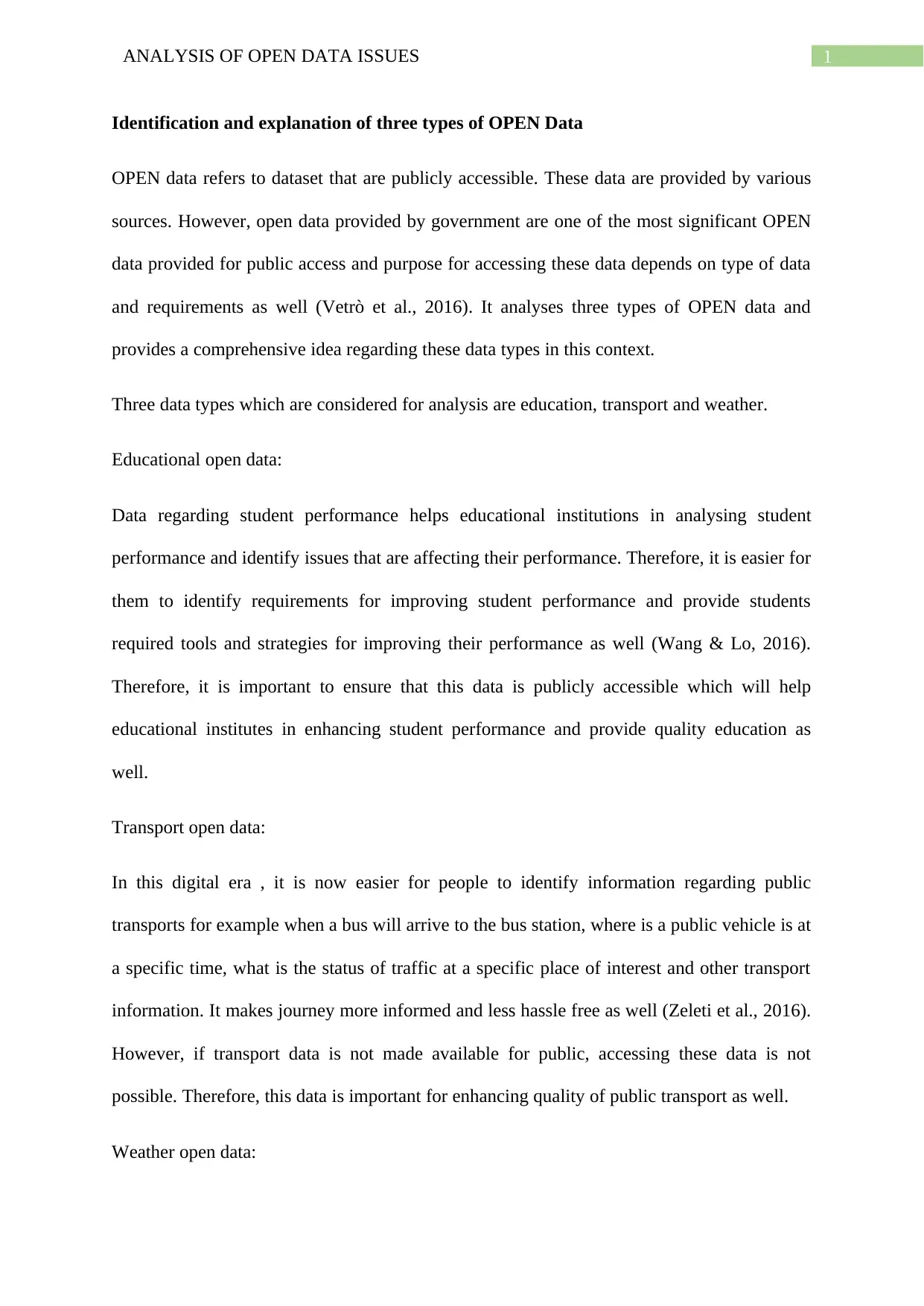
1ANALYSIS OF OPEN DATA ISSUES
Identification and explanation of three types of OPEN Data
OPEN data refers to dataset that are publicly accessible. These data are provided by various
sources. However, open data provided by government are one of the most significant OPEN
data provided for public access and purpose for accessing these data depends on type of data
and requirements as well (Vetrò et al., 2016). It analyses three types of OPEN data and
provides a comprehensive idea regarding these data types in this context.
Three data types which are considered for analysis are education, transport and weather.
Educational open data:
Data regarding student performance helps educational institutions in analysing student
performance and identify issues that are affecting their performance. Therefore, it is easier for
them to identify requirements for improving student performance and provide students
required tools and strategies for improving their performance as well (Wang & Lo, 2016).
Therefore, it is important to ensure that this data is publicly accessible which will help
educational institutes in enhancing student performance and provide quality education as
well.
Transport open data:
In this digital era , it is now easier for people to identify information regarding public
transports for example when a bus will arrive to the bus station, where is a public vehicle is at
a specific time, what is the status of traffic at a specific place of interest and other transport
information. It makes journey more informed and less hassle free as well (Zeleti et al., 2016).
However, if transport data is not made available for public, accessing these data is not
possible. Therefore, this data is important for enhancing quality of public transport as well.
Weather open data:
Identification and explanation of three types of OPEN Data
OPEN data refers to dataset that are publicly accessible. These data are provided by various
sources. However, open data provided by government are one of the most significant OPEN
data provided for public access and purpose for accessing these data depends on type of data
and requirements as well (Vetrò et al., 2016). It analyses three types of OPEN data and
provides a comprehensive idea regarding these data types in this context.
Three data types which are considered for analysis are education, transport and weather.
Educational open data:
Data regarding student performance helps educational institutions in analysing student
performance and identify issues that are affecting their performance. Therefore, it is easier for
them to identify requirements for improving student performance and provide students
required tools and strategies for improving their performance as well (Wang & Lo, 2016).
Therefore, it is important to ensure that this data is publicly accessible which will help
educational institutes in enhancing student performance and provide quality education as
well.
Transport open data:
In this digital era , it is now easier for people to identify information regarding public
transports for example when a bus will arrive to the bus station, where is a public vehicle is at
a specific time, what is the status of traffic at a specific place of interest and other transport
information. It makes journey more informed and less hassle free as well (Zeleti et al., 2016).
However, if transport data is not made available for public, accessing these data is not
possible. Therefore, this data is important for enhancing quality of public transport as well.
Weather open data:
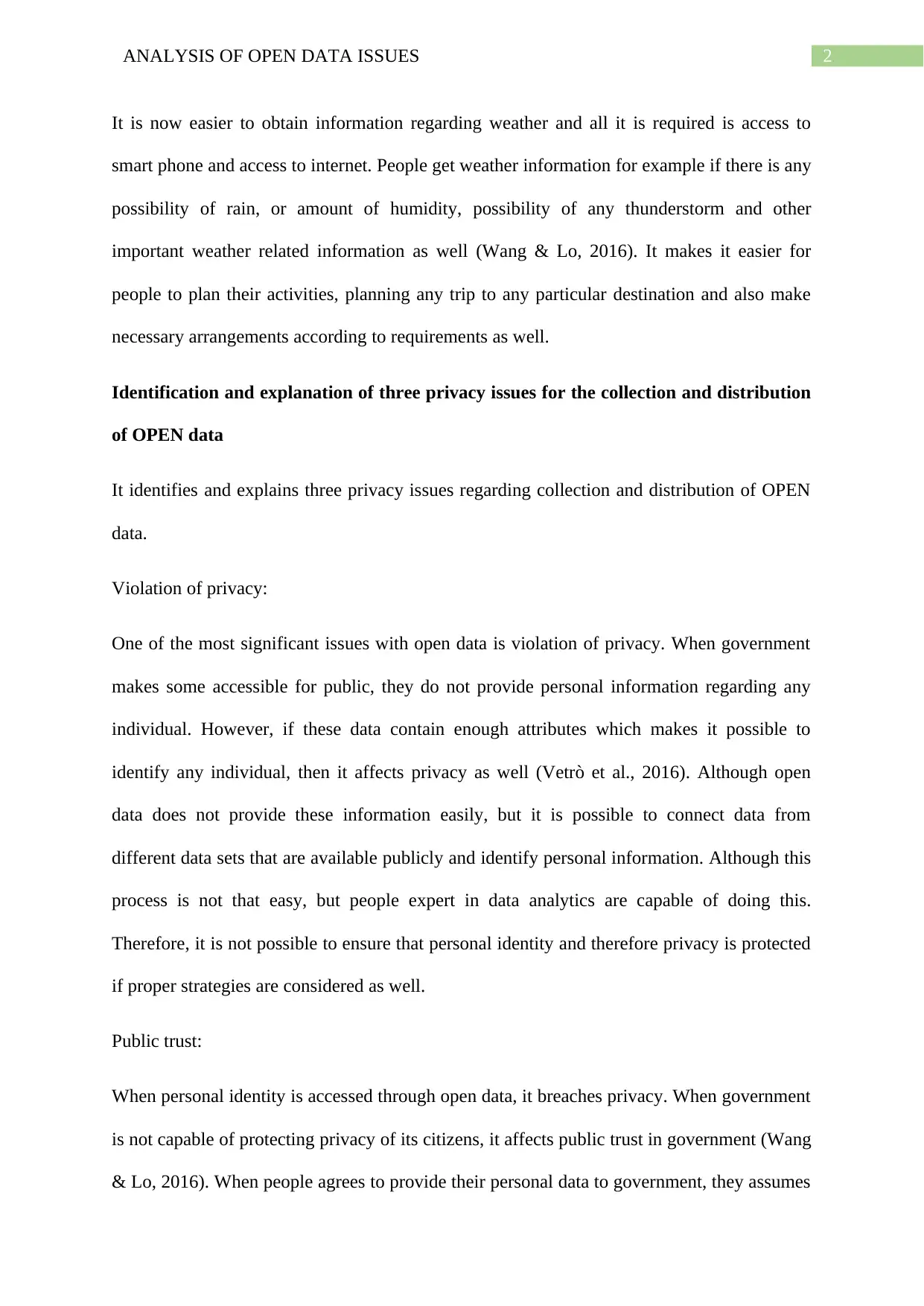
2ANALYSIS OF OPEN DATA ISSUES
It is now easier to obtain information regarding weather and all it is required is access to
smart phone and access to internet. People get weather information for example if there is any
possibility of rain, or amount of humidity, possibility of any thunderstorm and other
important weather related information as well (Wang & Lo, 2016). It makes it easier for
people to plan their activities, planning any trip to any particular destination and also make
necessary arrangements according to requirements as well.
Identification and explanation of three privacy issues for the collection and distribution
of OPEN data
It identifies and explains three privacy issues regarding collection and distribution of OPEN
data.
Violation of privacy:
One of the most significant issues with open data is violation of privacy. When government
makes some accessible for public, they do not provide personal information regarding any
individual. However, if these data contain enough attributes which makes it possible to
identify any individual, then it affects privacy as well (Vetrò et al., 2016). Although open
data does not provide these information easily, but it is possible to connect data from
different data sets that are available publicly and identify personal information. Although this
process is not that easy, but people expert in data analytics are capable of doing this.
Therefore, it is not possible to ensure that personal identity and therefore privacy is protected
if proper strategies are considered as well.
Public trust:
When personal identity is accessed through open data, it breaches privacy. When government
is not capable of protecting privacy of its citizens, it affects public trust in government (Wang
& Lo, 2016). When people agrees to provide their personal data to government, they assumes
It is now easier to obtain information regarding weather and all it is required is access to
smart phone and access to internet. People get weather information for example if there is any
possibility of rain, or amount of humidity, possibility of any thunderstorm and other
important weather related information as well (Wang & Lo, 2016). It makes it easier for
people to plan their activities, planning any trip to any particular destination and also make
necessary arrangements according to requirements as well.
Identification and explanation of three privacy issues for the collection and distribution
of OPEN data
It identifies and explains three privacy issues regarding collection and distribution of OPEN
data.
Violation of privacy:
One of the most significant issues with open data is violation of privacy. When government
makes some accessible for public, they do not provide personal information regarding any
individual. However, if these data contain enough attributes which makes it possible to
identify any individual, then it affects privacy as well (Vetrò et al., 2016). Although open
data does not provide these information easily, but it is possible to connect data from
different data sets that are available publicly and identify personal information. Although this
process is not that easy, but people expert in data analytics are capable of doing this.
Therefore, it is not possible to ensure that personal identity and therefore privacy is protected
if proper strategies are considered as well.
Public trust:
When personal identity is accessed through open data, it breaches privacy. When government
is not capable of protecting privacy of its citizens, it affects public trust in government (Wang
& Lo, 2016). When people agrees to provide their personal data to government, they assumes
⊘ This is a preview!⊘
Do you want full access?
Subscribe today to unlock all pages.

Trusted by 1+ million students worldwide
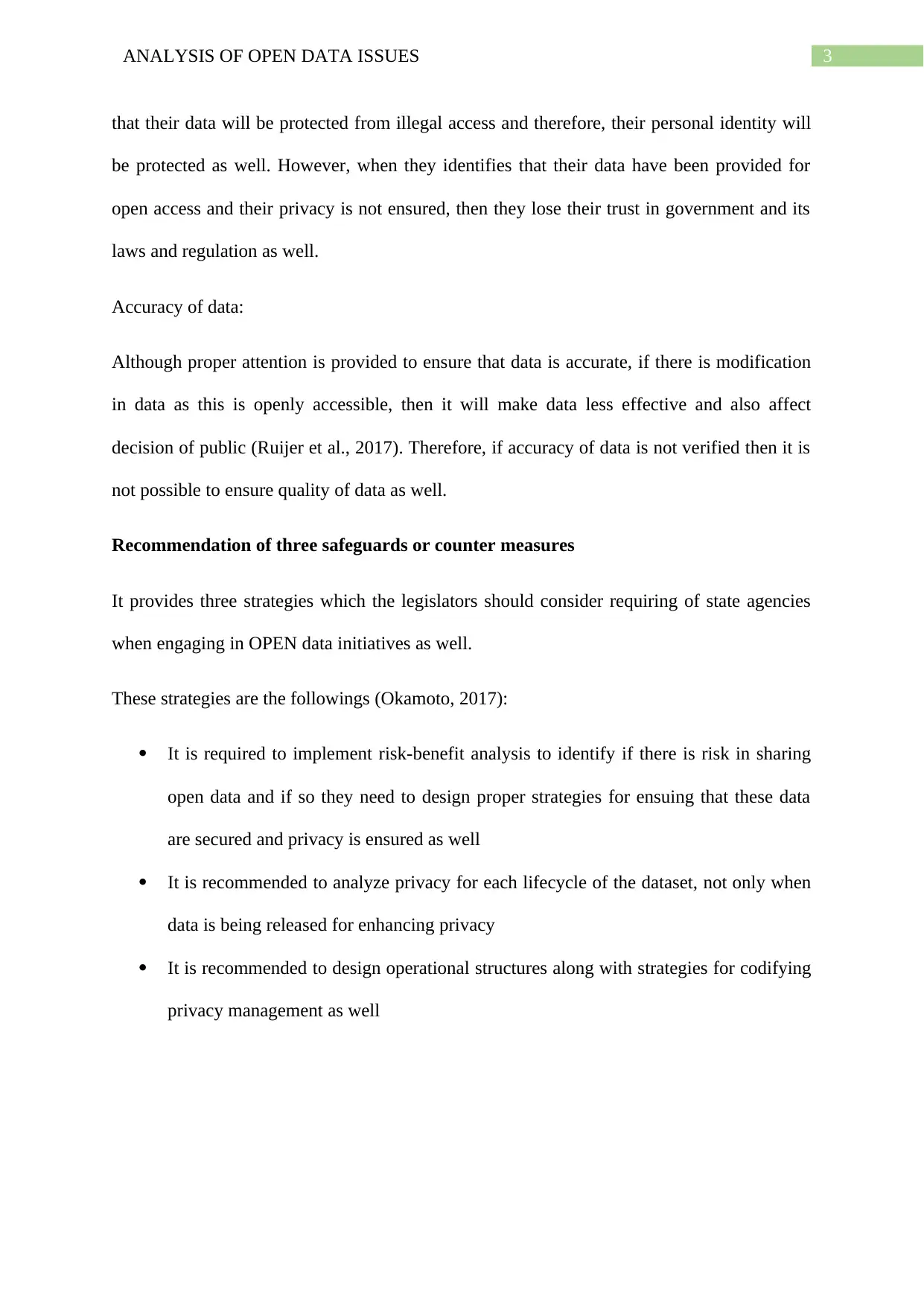
3ANALYSIS OF OPEN DATA ISSUES
that their data will be protected from illegal access and therefore, their personal identity will
be protected as well. However, when they identifies that their data have been provided for
open access and their privacy is not ensured, then they lose their trust in government and its
laws and regulation as well.
Accuracy of data:
Although proper attention is provided to ensure that data is accurate, if there is modification
in data as this is openly accessible, then it will make data less effective and also affect
decision of public (Ruijer et al., 2017). Therefore, if accuracy of data is not verified then it is
not possible to ensure quality of data as well.
Recommendation of three safeguards or counter measures
It provides three strategies which the legislators should consider requiring of state agencies
when engaging in OPEN data initiatives as well.
These strategies are the followings (Okamoto, 2017):
It is required to implement risk-benefit analysis to identify if there is risk in sharing
open data and if so they need to design proper strategies for ensuing that these data
are secured and privacy is ensured as well
It is recommended to analyze privacy for each lifecycle of the dataset, not only when
data is being released for enhancing privacy
It is recommended to design operational structures along with strategies for codifying
privacy management as well
that their data will be protected from illegal access and therefore, their personal identity will
be protected as well. However, when they identifies that their data have been provided for
open access and their privacy is not ensured, then they lose their trust in government and its
laws and regulation as well.
Accuracy of data:
Although proper attention is provided to ensure that data is accurate, if there is modification
in data as this is openly accessible, then it will make data less effective and also affect
decision of public (Ruijer et al., 2017). Therefore, if accuracy of data is not verified then it is
not possible to ensure quality of data as well.
Recommendation of three safeguards or counter measures
It provides three strategies which the legislators should consider requiring of state agencies
when engaging in OPEN data initiatives as well.
These strategies are the followings (Okamoto, 2017):
It is required to implement risk-benefit analysis to identify if there is risk in sharing
open data and if so they need to design proper strategies for ensuing that these data
are secured and privacy is ensured as well
It is recommended to analyze privacy for each lifecycle of the dataset, not only when
data is being released for enhancing privacy
It is recommended to design operational structures along with strategies for codifying
privacy management as well
Paraphrase This Document
Need a fresh take? Get an instant paraphrase of this document with our AI Paraphraser
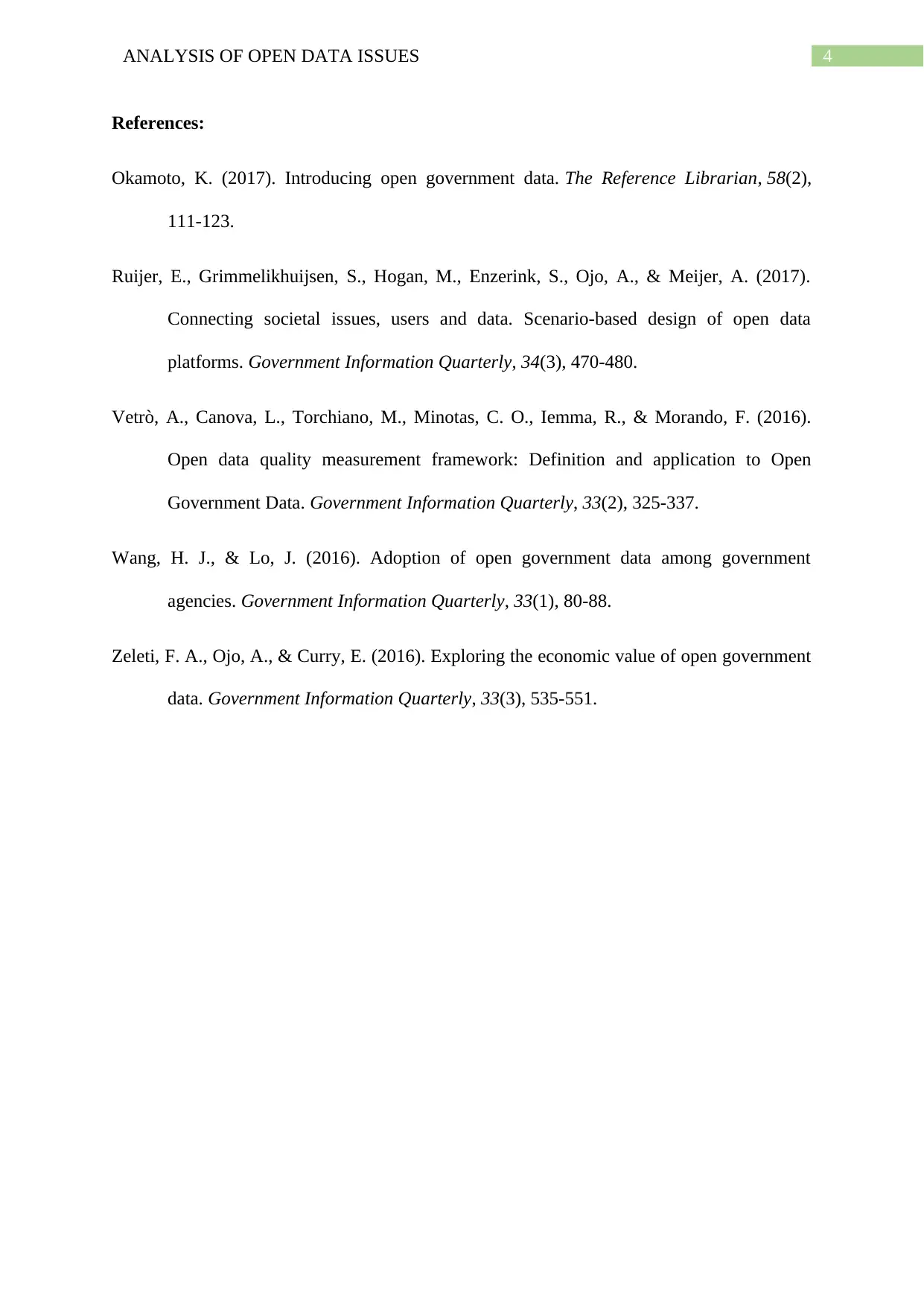
4ANALYSIS OF OPEN DATA ISSUES
References:
Okamoto, K. (2017). Introducing open government data. The Reference Librarian, 58(2),
111-123.
Ruijer, E., Grimmelikhuijsen, S., Hogan, M., Enzerink, S., Ojo, A., & Meijer, A. (2017).
Connecting societal issues, users and data. Scenario-based design of open data
platforms. Government Information Quarterly, 34(3), 470-480.
Vetrò, A., Canova, L., Torchiano, M., Minotas, C. O., Iemma, R., & Morando, F. (2016).
Open data quality measurement framework: Definition and application to Open
Government Data. Government Information Quarterly, 33(2), 325-337.
Wang, H. J., & Lo, J. (2016). Adoption of open government data among government
agencies. Government Information Quarterly, 33(1), 80-88.
Zeleti, F. A., Ojo, A., & Curry, E. (2016). Exploring the economic value of open government
data. Government Information Quarterly, 33(3), 535-551.
References:
Okamoto, K. (2017). Introducing open government data. The Reference Librarian, 58(2),
111-123.
Ruijer, E., Grimmelikhuijsen, S., Hogan, M., Enzerink, S., Ojo, A., & Meijer, A. (2017).
Connecting societal issues, users and data. Scenario-based design of open data
platforms. Government Information Quarterly, 34(3), 470-480.
Vetrò, A., Canova, L., Torchiano, M., Minotas, C. O., Iemma, R., & Morando, F. (2016).
Open data quality measurement framework: Definition and application to Open
Government Data. Government Information Quarterly, 33(2), 325-337.
Wang, H. J., & Lo, J. (2016). Adoption of open government data among government
agencies. Government Information Quarterly, 33(1), 80-88.
Zeleti, F. A., Ojo, A., & Curry, E. (2016). Exploring the economic value of open government
data. Government Information Quarterly, 33(3), 535-551.
1 out of 5
Related Documents
Your All-in-One AI-Powered Toolkit for Academic Success.
+13062052269
info@desklib.com
Available 24*7 on WhatsApp / Email
![[object Object]](/_next/static/media/star-bottom.7253800d.svg)
Unlock your academic potential
Copyright © 2020–2025 A2Z Services. All Rights Reserved. Developed and managed by ZUCOL.





